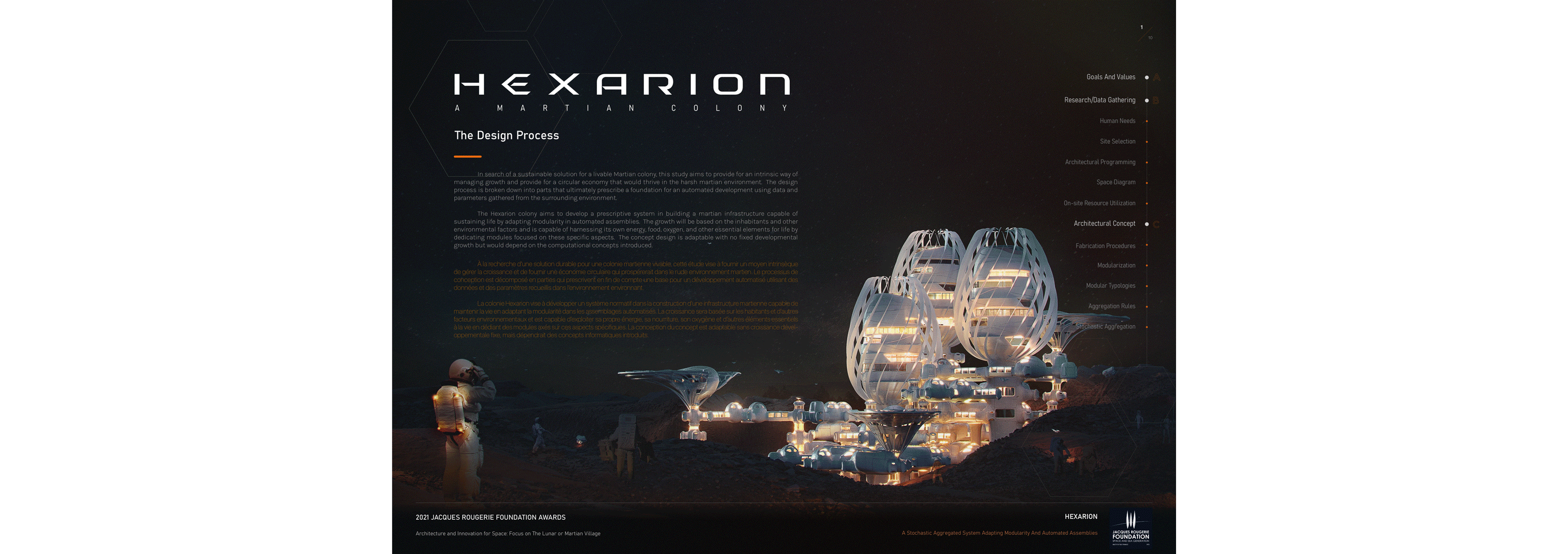top of page


WORLD ARCHITECTURE FESTIVAL 2022
FUTURE PROJECTS: COMPETITION ENTRIES CATEGORY
FINALIST
INTERNATIONAL ARCHITECTURE COMPETITION 2021
SPECIAL MENTION OF THE FOCUS PRIZE:

ARCHITECTURE AND INNOVATION FOR SPACE


In search of a sustainable solution for a livable Martian colony, this study aims to provide for an intrinsic way of managing growth and provide for a circular economy that would thrive in the harsh martian environment. The design process is broken down into parts that ultimately prescribe a foundation for an automated development using data and parameters gathered from the surrounding environment.
The Hexarion colony aims to develop a prescriptive system in building a martian infrastructure capable of sustaining life by adapting modularity in automated assemblies. The growth will be based on the inhabitants and other environmental factors and is capable of harnessing its own energy, food, oxygen, and other essential elements for life by dedicating modules focused on these specific aspects. The concept design is adaptable with no fixed developmental growth but would depend on the computational concepts introduced.
DESIGN PROCESS
THE SITE

HUMAN NEEDS
To support human life on mars, there is a need to identify basic human needs and how to manage them. Below is an infographic showing the basic needs of one modern human for subsistence per year.
822 kg
200 750 kg
111 398 kg

730 kg
FOOD
Disposable Food Package Hydroponic Farming
Processed Organic Waste
WATER
Treated Martian Water Processed Urine
CONVERTED CO²
Converted CO²
WASTE FACILITY
Temporary Storage Facility Recycling and
Processing Incineration
GOALS AND VALUES

Automation

Sustainability

Self-Assembly

Modularisation
The infrastructure of the colony needs to minimize the reliance on human labor and must be able to sustainably support life and manage the overall building lifecycle. To be able to achieve this, four goals were identified which will be the guiding principles of the overall design concept. The colony could achieve sustainability by identifying core typological spaces and separating their importance through modularisation. Construction of these infrastructures must implement automated self-assembly with different fitness values that parametrically dictate the growth of the system.
SITE SELECTION
To support human life on mars, there is a need to identify basic human needs and how to manage them. Below is an infographic showing the basic needs of one modern human for subsistence per year.



The parts become modular due to the introduction of the hexagon format as guiding principles for the proliferation of the development on the macro scale. The typology of the space for each module can also be modified depending on the usage of the module on a micro-scale. Even each type of module can be different depending on the usage and parameter requirements for each.
These modules are the different parts for the colony aggregation. Each module would serve a vital role in the overall infrastructure and ecosystem of the residential pod.
As the colony grows, system automations are in play to dictate how the modules will be connected in proportion to the decisions and needs of the colony.
MODULARISATION
bottom of page


